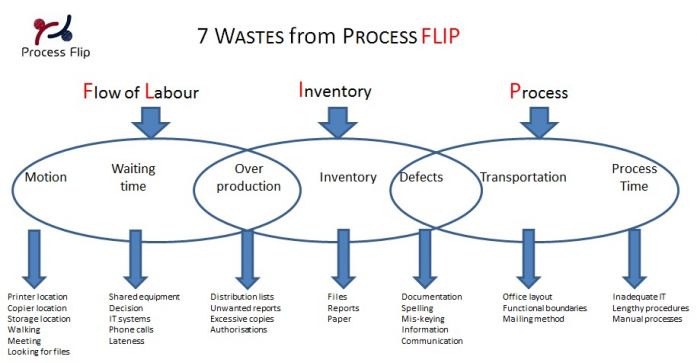Are there 7 wastes? Are there 8 Wastes? Is there any waste at all?
The issue of waste in business processes is an interesting one. The diagram on this blog is a standard one and adequately highlights where there could be waste in your business processes.

But does waste matter? Is all waste bad?
Well we can all be guilty of not being fully productive all of the time. Social Media is often described as an easy way to waste a lot of time. Indeed, spending time checking out Facebook, catching up on Twitter, even researching articles on LinkedIn, all are, if not non-productive, at least low productive activities. However, without some of them in our lives we would be less than human and more robotic. So - we may have the photocopier/printer in the wrong place in the office and that may waste time for some staff during the day, but does it matter that much? In most cases probably not.
But what these lists of 7 or 8 wastes do for us is point us in directions for improvement. When we as a business are not optimal, then we add cost to our processes, delay in our service delivery and inconsistency to our quality. All in all we provide our customers with the less than perfect experience. So what do we at Process Flip feel are the 3 things you could do now to start on the road to process maturity and excellence.
- Look at the productive activities and see what proportion of the total process time they are.
Most process improvement methodologies lookat the different things that happen in a process and break them down in to those activities that ensure the outcome is delivered. If you are making a car actually working on the car by putting on a wheel, would be productive.
How long does this and similarly productive activity take?
How long transpires from the start of the process to the end of the process?
Somewhere between these two figures there will be time taken on non-productive tasks and waiting time. You may want to add on time it took to make stuff that seemed productive but was never needed.
It is the difference between productive time and total time that is the start of the problem. Start to work on how to close this gap, and you have started on the road to process improvement.
- How consistent is your delivery?
If you have different teams working on the same processes, do they all work the same way? If you have the same inputs, are the outputs consistent. If not, perhaps the procedures are not working, being followed or are completely out of date.
To get consistent, optimised, delivery run some workshops now and discuss as a team how you processes work. Every workshop I have ever been involved with delivers some improvement, stops inappropriate tasks and reduced waste.
Once defined, document. Model your business in a process modelling software, publish the processes, turn them in to procedures and manage the improvement.
- Repeat activities 1 and 2
Continuous improvement is a mind-set, a culture, a way of life. If it isn’t that in your organisation it should be. I met a councillor or a local authority once who said to me: “Continuous Improvement – we did that last year.” Interesting definition to ‘continuous’ I thought.
No, this is not earth shattering news. Yes you have heard this before. So why are so many organisations not doing it? Well there is more to it, but start with this and you’ve started.


